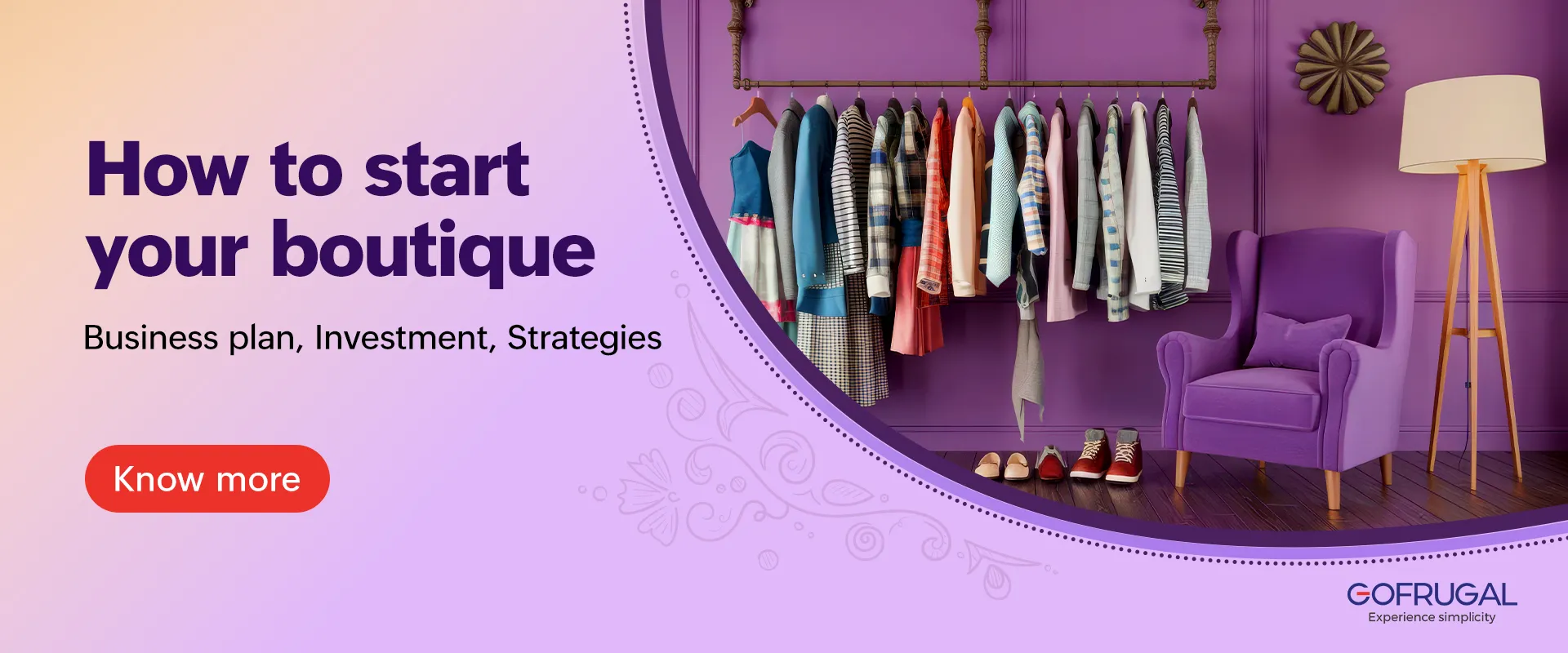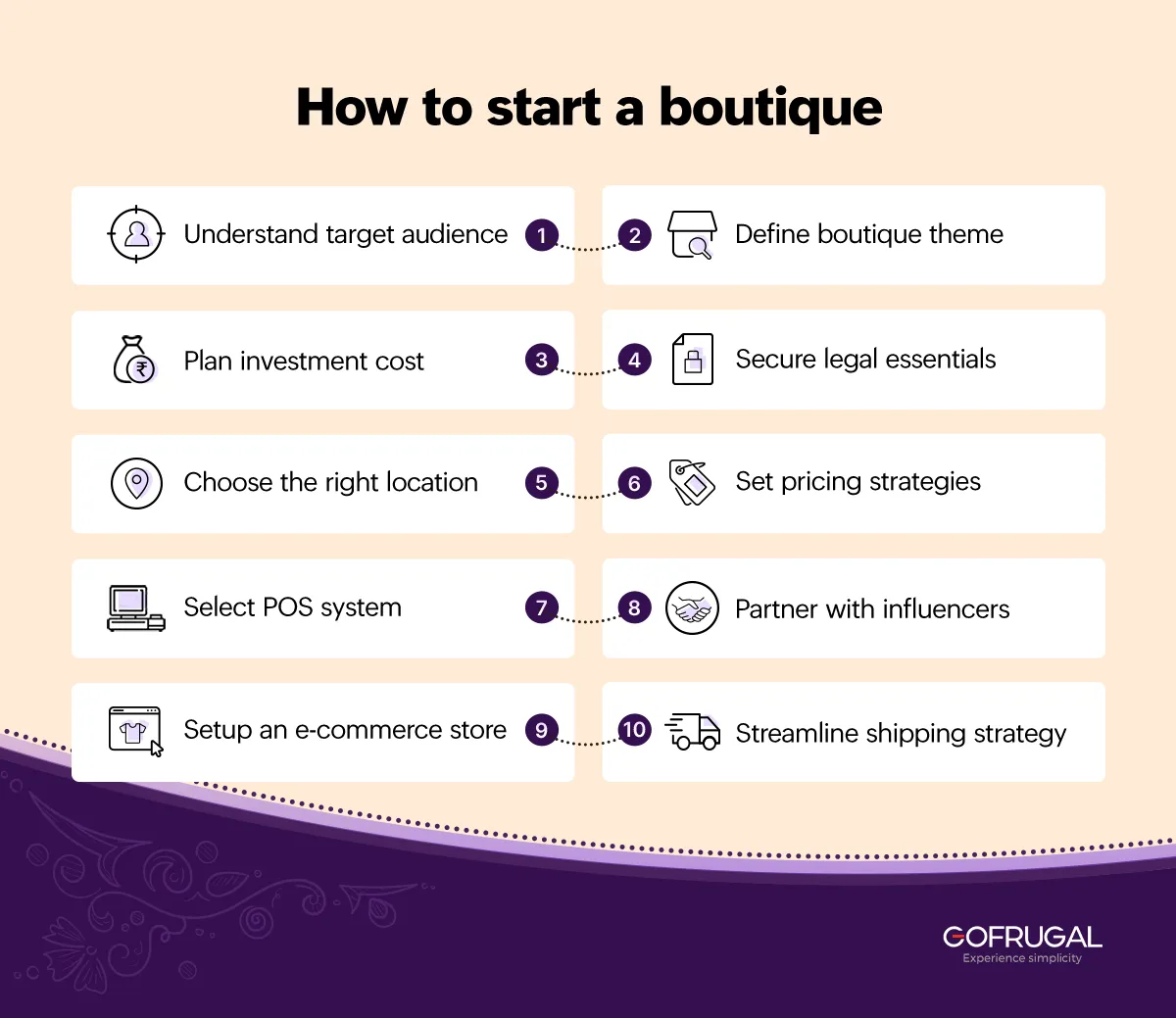Key takeaways:
- Learn the steps to define your boutique theme, understand your target audience, and estimate investment costs.
- Discover the importance of legal compliance, choosing the right location, and using tools like POS systems to manage your boutique.
- Explore marketing strategies, influencer partnerships, and e-commerce tools to grow your boutique business effectively.
Opening a boutique is for those who see fashion as more than clothes on a rack—it’s about expressing a vibe, setting trends, and connecting with customers on a personal level. For boutique owners, every product has a story, and every detail is part of a curated experience. If you’re passionate about creating something one-of-a-kind, this blog will walk you through the steps to launch a successful boutique, from selecting niche inventory to using the latest POS technology. Explore how to make your boutique a standout destination in your community and beyond.
What makes a boutique business unique?
Boutiques focus on curated and specialized offerings, catering to a specific target audience that values style, exclusivity, and a personalized shopping experience. Unlike large apparel stores, boutique owners don’t just stock everything; they carefully select items that match a distinct theme or aesthetic. This allows boutique businesses to form deeper connections with their customers, which often translates to strong loyalty.
Customers visiting a boutique often seek something special, and boutique owners can cater to this desire by selecting unique styles or niche products. This curated approach enables boutique owners to build a brand with personality and charm, fostering stronger customer loyalty.
Understanding your target market
Identifying your target market is a foundational step for any boutique. The more you understand your ideal customer, the better you can tailor your inventory and brand experience. Key questions to guide your market research include:
- Who is your ideal customer?
- What are their shopping preferences?
- What age range, lifestyle, and income level do they belong to?
To gather insights, you can use online tools like Google Analytics, social media surveys, and platforms that provide customer demographics. This research will be the basis for your branding, marketing, and product selection, helping you create a boutique experience that resonates with your chosen audience.
Deciding what to sell and sourcing inventory
Your inventory is the heart of your boutique, so choose products that align with your brand’s identity and the preferences of your target market. Here’s how to get started.
- Define your boutique theme: Whether it’s vintage, bohemian, eco-friendly, or modern chic, your theme sets the tone for your entire business.
- Explore sourcing options: You can source from local artisans, wholesalers, online marketplaces, or even work with designers for exclusive pieces.
- Use POS software for inventory management: A reliable POS system can streamline inventory management, so you always have stock on hand while reducing manual tracking. This is essential for boutiques where having the right products at the right time can significantly impact sales.
Investment cost: Estimating startup expenses
Starting a boutique requires careful budgeting. Here are some common costs you’ll need to consider.
- Store setup costs: Rent, interior design, and essential furnishings for a physical store.
- Inventory costs: Purchasing your first batch of inventory.
- Marketing costs: Both digital and offline marketing efforts to build brand awareness.
- Operational costs: Monthly expenses like utilities, payroll, and software subscriptions (including POS software).
Planning these expenses in advance will help you set realistic financial goals and avoid unexpected costs as you start.
Legal considerations when opening a boutique in India
Starting a boutique in India involves several legal and regulatory steps to ensure compliance and protect your business. Here are the essentials.
Register your business
- Choose a business structure: Decide whether you want to register as a sole proprietorship, partnership, or private limited company, depending on the scale and vision of your boutique.
- Business name registration: Ensure your boutique’s name is unique and register it with the Ministry of Corporate Affairs (MCA), if setting up a company. For sole proprietorships, register the name with local authorities.
- GST registration: This is mandatory if your annual turnover exceeds ₹20 lakhs (₹10 lakhs for northeastern states) or if you plan to sell goods online.
Obtain permits and licenses
Running a boutique in India typically requires the following licenses and permits.
- Shop and establishment license: Required under the respective state’s Shop and Establishment Act to operate a retail business.
- Trade license: Issued by the local municipal corporation to authorize business activities.
- GSTIN: For collecting and remitting Goods and Services Tax (GST).
- Fire safety certificate: If the boutique occupies a significant area or operates in a commercial complex.
- Signage permit: If you’re putting up a signboard outside your boutique.
- Pollution certificate (if applicable): Required for certain materials, such as dyeing or fabric production, that may involve environmental concerns.
It’s best to check with your local municipal corporation for specific requirements in your area.
Trademark your brand
- Secure your name and logo: Trademarking ensures your boutique name, logo, or tagline is legally protected.
- Apply for a trademark: File your application through the Controller General of Patents, Designs, and Trade Marks or consult a professional trademark attorney for guidance.
Other legal protections
- Contracts with suppliers: Draft clear agreements with vendors to define terms for inventory sourcing, payment schedules, and return policies.
- Insurance: Invest in shop insurance to protect against risks like fire, theft, and third-party liability.
Helpful resources in India
Here are some resources to assist you in navigating legalities.
- Startup India: A government initiative providing resources for new businesses.
- Ministry of Corporate Affairs (MCA): For company registration and compliance.
- IP India Trademark Registration: For trademark search and registration.
- GST Portal: For GST registration and filing. Getting these legalities in place early ensures you avoid fines and protects your boutique in the long run.
Choosing the right location and designing shop interiors
- Foot traffic: Pick a location with high foot traffic—like busy streets or shopping areas—to maximize walk-ins and visibility.
- Customer fit: Choose an area where your target customers shop. Align your boutique's style with the neighborhood's typical demographics and lifestyle.
- Visibility and access: Ensure the storefront is easy to see and access, with nearby parking or public transportation for convenience.
- Budget-friendly lease: Select a location within your budget, ideally with flexible lease terms to allow for changes as your business grows.
- Store layout and ambiance: Design an inviting space that reflects your boutique’s aesthetic. Lighting, layout, and display arrangements can greatly enhance the customer experience. Position your POS system in a central, accessible area for efficient checkouts and customer assistance.
Pricing strategies for boutique businesses
Setting the right price for your products is essential to make a profit while staying competitive. Boutiques often focus on unique and high-quality items, so using a value-based pricing strategy works well. Here are a few tips and pricing strategies that can work specifically for boutique stores.
- Value-based pricing: Highlight the uniqueness and quality of your items to justify a slightly higher price than large chain stores. Customers who shop at boutiques are often willing to pay more for exclusivity.
- Bundle pricing: Encourage customers to buy items together, like pairing a dress with accessories. Bundling items helps increase the total purchase value and offers customers a slight discount for buying more.
- Psychological pricing: Set prices just below a round number to make items seem more affordable. For instance, pricing an item at Rs.499 instead of Rs.500 can make it feel like a better deal.
- Seasonal or limited-time discounts:Offer discounts during off-seasons or special sales events. Limited-time offers create urgency and can drive more sales without permanently lowering prices.
For a detailed pricing strategy, check out our dedicated blog post on boutique pricing strategies.
How to choose a POS system for your boutique
A point of sale (POS) system is more than just a cash register; it’s the backbone of your store’s operations. Here’s how to choose the right POS system for a boutique.
- Inventory management features: For boutiques, tracking inventory in real time is crucial. Look for a POS system that offers automated inventory updates to help you avoid understocking or overstocking.
- Centralized data for online and offline sales: If you plan to sell both online and in-store, choose a POS system that synchronizes inventory and sales data across both channels.
- Customer relationship management (CRM): Some POS systems offer CRM tools that allow you to store customer preferences, track purchasing history, and offer personalized recommendations.
- User-friendly interface: Boutique owners often have small teams, so a simple, intuitive POS interface ensures quick, efficient transactions.
Setting up an online boutique store
An online boutique allows you to expand your reach beyond your local area. Here’s how to set it up.
- Choose an ecommerce platform: Shopify, WooCommerce, and BigCommerce are popular platforms that support boutique businesses with customizable themes.
- Sync with your physical store: Use a POS system that integrates both in-store and online inventory, ensuring stock is updated in real time to prevent errors.
- Optimize for mobile shoppers: Many online shoppers browse on their phones, so ensure your site is mobile-friendly and offers easy checkout options.
Marketing strategies for boutique stores (online and offline)
Marketing is essential for getting your boutique noticed, attracting new customers, and boosting sales. Here are some effective and trendy marketing strategies for boutique owners, blending both online and offline tactics.
Social media marketing
Social media is one of the most powerful tools for boutique stores. Platforms like Instagram, Pinterest, and Facebook let you share beautiful images, showcase new arrivals, and connect directly with fashion-enthusiastic shoppers. Here are a few ways to make the most of social media.
- Instagram and Facebook stories: Share daily updates, new products, or store happenings in short, engaging videos.
- Behind-the-scenes content: Show the creative side of your business, like product sourcing or how items are styled. This helps build a deeper connection with followers.
- Shoppable posts: Use Instagram Shopping or Facebook Shops to allow customers to buy items directly from your social media pages, making it easy for them to purchase from you.
Local marketing
Connecting with your local community is crucial for boutique stores, as many customers may come from nearby. Local marketing can involve different initiatives.
- Hosting in-store events: Organize events like styling workshops, seasonal launches, or trunk shows to attract people to your store and encourage social sharing.
- Collaborate with local businesses: Partner with complementary businesses (like coffee shops or salons) for cross promotions. For example, offer discounts to each other’s customers or co-host events.
- Participate in pop-up shops: Setting up pop-up booths at local events or markets introduces your brand to new customers who may not have visited your boutique yet.
Loyalty programs and exclusive events
Building loyalty is key to creating long-term customers. A loyalty program can reward frequent shoppers, encouraging them to return to your boutique. Here’s how to make it effective.
- Reward points: Offer points for every purchase, which can be redeemed for discounts or special items. This keeps customers coming back to earn and use their rewards.
- Personalized offers: Use your POS system to track customer preferences and offer personalized discounts or promotions, making each customer feel special.
Influencer partnerships
Partnering with influencers is a great way to extend your reach. Influencers who match your boutique's style can introduce your brand to new audiences. Try the following tactics.
- Local influencers: Collaborate with local influencers to help reach potential customers nearby. They can share your products on social media, bringing new customers directly to your boutique.
- Micro-influencers: Working with smaller influencers who have a loyal following is often more cost-effective and can feel more authentic to followers. These influencers usually have high engagement rates and are trusted by their audience.
Online ads and Google My Business
Online advertising helps reach a wider audience, even beyond your local area. Consider using:
- Facebook and Instagram ads: Target specific demographics (like age, location, or interests) to show your ads to those most likely to love your boutique.
- Google My Business: Create a profile for your boutique to show up in local searches. This can help people in your area find your boutique when searching for shops nearby.
How Gofrugal can help manage your boutique store
Running a boutique is simpler with the right tools. Here’s how Gofrugal can support your boutique business.
- Online and offline store integration: Gofrugal POS seamlessly integrates your online and offline stores, enabling precise, real-time inventory tracking and reducing stock issues.
- Inventory management: With the GoSure app, track daily inventory and use age-based tracking to discount older items, keeping your stock fresh and appealing.
- Real-time sales insights: The WhatsNow app provides instant insights on bestsellers, helping you plan purchases based on customer preferences and trends.
- Flexible checkout: Manage in-store and online sales from one system, with multiple payment options for smooth, efficient checkouts.
- Loyalty programs: Create tailored loyalty programs, offering rewards and discounts to build customer loyalty and increase return visits.
- Salesperson commission management: Set up slab-wise commissions to motivate sales associates, rewarding them based on their sales performance.
- Matrix item management: Easily track variations like sizes, colors, and styles, simplifying inventory management for boutique-specific needs.
- Reports and accounting tools: Access customizable dashboards for detailed reports on sales, expenses, and profits, with built-in accounting tools to manage finances efficiently.
Ready to launch your dream boutique?
Your boutique journey is just beginning; with the right mix of creativity, dedication, and smart tools, you can build a store that truly resonates with your customers. By combining your unique touch with tools like Gofrugal POS, you can handle day-to-day tasks seamlessly and focus on what you do best: curating an exceptional shopping experience. Take these steps forward, and watch your boutique evolve into a fashion haven loved by all.



